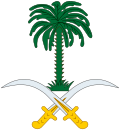Saudi Arabia–Yemen relations
 From Wikipedia - Reading time: 8 min
From Wikipedia - Reading time: 8 min
This article needs to be updated. (March 2015) |
 | |
Saudi Arabia |
Yemen |
|---|---|
Saudi Arabia and Yemen relations refers to the current and historical relationship between the neighbouring sovereign states of Saudi Arabia and Yemen. The two countries at one time did enjoy good relations and closely cooperated in military, economic and cultural issues.[1] Now because of the ongoing Yemeni Civil War and the realignments of power in the Middle East with the emergence of al-Qaeda and the radicalization of some factions of Islam, Saudi Arabia has led a military intervention into Yemen.
History
[edit]This section needs expansion. You can help by adding to it. (September 2015) |
Modern Saudi-Yemeni relations began in 1803 with an attack by Saudi forces of the territory of Zaydi Imamate with the help of some local Yemeni tribes. The Saudis won and had control over the Tihama region until 1818 when the forces of the Ottoman khedive of Egypt, Mohammed Ali Pasha, destroyed the Saudi state.[2]
The establishment of a protectorate over the Idrisi sultanate in Asir led to clashes between Ibn Saud and imam Yahya of Yemen. Ibn Saud captured Asir and Jizan while the imam managed to occupy the oasis of Najran.[3] Negotiations proved fruitless, the Saudis regained control over Najran and occupied about 100 kilometers of the coastal plain[4] In 1948, Saudi Arabia provided aid to Imam Ahmed fearing the "constitutional" nature of an uprising in Yemen.[5]
In 1934, the Saudi–Yemeni War broke out with a Yemeni invasion, responded by strong Saudi offensive. The war ended with Yemen relinquishing control of three modern Saudi provinces, Asir, Jizan and Najran. Since then, the two countries have always had a complicated relationship.[6]
Decades later in 2015, Saudi Arabia invaded Yemen again (with the help of the UAE, Bahrain and Qatar).[7][8] Yemen then started to fire rockets and drones at Saudi Arabia, UAE, Israel, Jordan and Egypt.[9][10]
Tensions with Saleh Government
[edit]Ali Abdullah Saleh served as president of North Yemen, and then a united Yemen between 1978 and 2012. Over these three fraught decades, Yemen's relationship with Saudi Arabia oscillated between low points like Saleh's siding with Saddam Hussein during the first Gulf War, to deepening Saudi sponsorship during the first decade of the War On Terror.
Saleh's falling out of Saudi favor was a contributing factor to his fall from power in 2012. His attempt to regain power by allying with the Houthis, who he had once used the Saudi Air Force to bomb, eventually led to his assassination in December 2017.[11]
1998 clash
[edit]| 1998 Saudi Arabia-Yemen clashes | |||||||||
|---|---|---|---|---|---|---|---|---|---|
| |||||||||
| Belligerents | |||||||||
|
|
| ||||||||
| Casualties and losses | |||||||||
| unknown | 3 dead, 9 injured | ||||||||
Saudi Arabia and Yemen clashed over Duwaima Island in July 1998. According to Yemen, Saudi Arabia sent nine naval vessels to seize the island on 21 July, killing three Yemeni coast guards and injuring nine. The attack was reportedly preceded by a nine-hour artillery bombardment.[12] Two days later, the Yemenis claimed to have landed on the island and retaken it,[13] but this was disputed by Saudi Arabia, who claimed to hold control of 75% of the island.[12]
Border
[edit]In September 2003, in an effort by the Saudi government to control incursions by Yemenis into Saudi Arabia and slow terrorist actions, the Saudis began construction of a wall of cement-filled pipeline, 10 feet (3.0 meters) in diameter along its border with Yemen. Following complaints by the Yemeni government to the Saudis that construction of the wall violated a year 2000 treaty between the two nations, the Saudis stopped work on the wall in February 2004. But by that time, 47 miles (76 kilometers) of cement-filled barrier, of the 1,100 miles (1,800 kilometers) border had been erected.
See also
[edit]- Foreign relations of Saudi Arabia
- Foreign relations of Yemen
- List of ambassadors of Saudi Arabia to Yemen
- Saudi Arabia–Yemen border
References
[edit]- ^ Saudi-Yemeni Relations: Domestic Structures and Foreign Influence By F. Gregory Gause p.4 ISBN 978-0-231-07044-7 Columbia University Press
- ^ Saudi-Yemeni Relations: Domestic Structures and Foreign Influence By F. Gregory Gause p.57
- ^ Saudi-Yemeni Relations: Domestic Structures and Foreign Influence By F. Gregory Gause p.58
- ^ A History of Modern Yemen By Paul Dresch 35
- ^ Saudi-Yemeni Relations: Domestic Structures and Foreign Influence By F. Gregory Gause 58
- ^ "Not too strong, not too weak: Saudi Arabia's policy towards Yemen" (PDF). Archived from the original (PDF) on 30 January 2020.
- ^ Mazzetti, Mark; Kirkpatrick, David D. (25 March 2015). "Saudi Arabia Leads Air Assault in Yemen". The New York Times. ISSN 0362-4331. Retrieved 21 February 2024.
- ^ "War in Yemen". Global Conflict Tracker. Retrieved 17 November 2023.
- ^ Ben-Ari, Lior (1 November 2023). "Not content with harming Israel, the Houthis lock horns with the UAE and the Saudis". Ynetnews. Retrieved 17 November 2023.
- ^ "Why Yemeni Houthis' attack on Israel has many worried". The Indian Express. 1 November 2023. Retrieved 17 November 2023.
- ^ Nianias, Helen (2 December 2017). "Landmark shift in Yemen crisis as former president reaches out to Saudi adversaries". The Telegraph – via www.telegraph.co.uk.
- ^ a b Jehl, Douglas (26 July 1998). "Border Clash Heightens Yemen-Saudi Tensions". The New York Times. Retrieved 25 September 2023.
- ^ Jehl, Douglas (26 July 1998). "Border row with the Saudis". al-bab. Retrieved 25 September 2023.
Bibliography
[edit]Gause, F. Gregory, (1990), Saudi-Yemeni Relations: Domestic Structures and Foreign Influence, Columbia University Press, ISBN 9780231070447.
 KSF
KSF